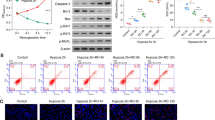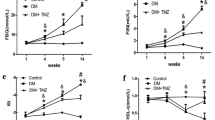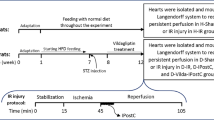Abstract
Type 1 diabetes (T1DM) portends poor prognosis concerning ischemic heart disease. Adiponectin (APN), an adipocytokine possessing insulin sensitizing and metabolic regulatory effects, has been recognized as a potent cardioprotective molecule. However, the relationship between APN and T1DM remains controversial and the role of cardiac-derived APN in T1DM is unclear. This study is aimed to investigate the dynamic change of both plasma and cardiac-derived APN expressions in T1DM, and the particular role of cardiac-derived APN in T1DM against myocardial ischemia/reperfusion (MI/R) injury. T1DM was established via intraperitoneal injection of streptozocin and followed by twice-daily subcutaneous injection of insulin or vehicle for 14 days. Non-diabetic mice of wild type and APN knockout were subjected to insulin or vehicle injection. MI/R was induced in Langendorff-perfused hearts. Compared to non-diabetic mice, plasma APN levels of diabetic mice significantly increased at 7 days, and slightly decreased at 14 days, while cardiac-derived APN levels gradually decreased over time. The MI/R injury measured as infarct size and cardiomyocyte apoptosis nearly doubled in diabetic mice. 14 days of insulin treatment increased both plasma and cardiac-derived APN levels in diabetic mice and attenuated myocardial injury via increasing AMPK phosphorylation in T1DM, which was partly reversed by Compound C (an AMPK inhibitor). Moreover, APN deficiency aggravated MI/R injury and partly abolished the protective effect of insulin treatment against MI/R injury, which was associated with decreased AMPK phosphorylation. The results suggest that cardiac-derived APN stimulated by long-term insulin treatment in T1DM exerts cardioprotection against MI/R injury via myocardial AMPK activation.





Similar content being viewed by others
References
Alvarsson M, Sundkvist G, Lager I, Henricsson M, Berntorp K, Fernqvist-Forbes E, Steen L, Westermark G, Westermark P, Orn T, Grill V (2003) Beneficial effects of insulin versus sulphonylurea on insulin secretion and metabolic control in recently diagnosed type 2 diabetic patients. Diabetes Care 26:2231–2237. doi:10.2337/diacare.26.8.2231
Bell RM, Clark JE, Hearse DJ, Shattock MJ (2007) Reperfusion kinase phosphorylation is essential but not sufficient in the mediation of pharmacological preconditioning: characterisation in the bi-phasic profile of early and late protection. Cardiovasc Res 73:153–163. doi:10.1016/j.cardiores.2006.10.013
Chen HS, Wu TE, Jap TS, Hsiao LC, Lee SH, Lin HD (2008) Beneficial effects of insulin on glycemic control and beta-cell function in newly diagnosed type 2 diabetes with severe hyperglycemia after short-term intensive insulin therapy. Diabetes Care 31:1927–1932. doi:10.2337/dc08-0075
Chu LM, Osipov RM, Robich MP, Feng J, Sheller MR, Sellke FW (2010) Effect of thrombin fragment (TP508) on myocardial ischemia reperfusion injury in a model of type 1 diabetes mellitus. Circulation 122:S162–S169. doi:10.1161/CIRCULATIONAHA.109.928374
Cui XB, Wang C, Li L, Fan D, Zhou Y, Wu D, Cui QH, Fu FY, Wu LL (2012) Insulin decreases myocardial adiponectin receptor 1 expression via PI3 K/Akt and FoxO1 pathway. Cardiovasc Res 93:69–78. doi:10.1093/cvr/cvr273
Ding G, Qin Q, He N, Francis-David SC, Hou J, Liu J, Ricks E, Yang Q (2007) Adiponectin and its receptors are expressed in adult ventricular cardiomyocytes and upregulated by activation of peroxisome proliferator-activated receptor gamma. J Mol Cell Cardiol 43:73–84. doi:10.1016/j.yjmcc.2007.04.014
Fein FS, Strobeck JE, Malhotra A, Scheuer J, Sonnenblick EH (1981) Reversibility of diabetic cardiomyopathy with insulin in rats. Circ Res 49:1251–1261. doi:10.1161/01.RES.49.6.1251
Fonseca VA (2003) Management of diabetes mellitus and insulin resistance in patients with cardiovascular disease. Am J Cardiol 92:50J–60J. doi:10.1016/S0002-9149(03)00616-7
Furnary AP, Gao G, Grunkemeier GL, Wu Y, Zerr KJ, Bookin SO, Floten HS, Starr A (2003) Continuous insulin infusion reduces mortality in patients with diabetes undergoing coronary artery bypass grafting. J Thorac Cardiovasc Surg 125:1007–1021. doi:10.1067/mtc.2003.181
Galler A, Gelbrich G, Kratzsch J, Noack N, Kapellen T, Kiess W (2007) Elevated serum levels of adiponectin in children, adolescents and young adults with type 1 diabetes and the impact of age, gender, body mass index and metabolic control: a longitudinal study. Eur J Endocrinol 157:481–489. doi:10.1530/EJE-07-0250
Gao F, Gao E, Yue TL, Ohlstein EH, Lopez BL, Christopher TA, Ma XL (2002) Nitric oxide mediates the antiapoptotic effect of insulin in myocardial ischemia–reperfusion: the roles of PI3-kinase, Akt, and endothelial nitric oxide synthase phosphorylation. Circulation 105:1497–1502. doi:10.1161/01.CIR.0000012529.00367.0F
Ghaboura N, Tamareille S, Ducluzeau PH, Grimaud L, Loufrani L, Croue A, Tourmen Y, Henrion D, Furber A, Prunier F (2011) Diabetes mellitus abrogates erythropoietin-induced cardioprotection against ischemic-reperfusion injury by alteration of the RISK/GSK-3beta signaling. Basic Res Cardiol 106:147–162. doi:10.1007/s00395-010-0130-3
Goldstein BJ, Scalia RG, Ma XL (2009) Protective vascular and myocardial effects of adiponectin. Nat Clin Pract Cardiovasc Med 6:27–35. doi:10.1038/ncpcardio1398
Guo Z, Xia Z, Yuen VG, McNeill JH (2007) Cardiac expression of adiponectin and its receptors in streptozotocin-induced diabetic rats. Metabolism 56:1363–1371. doi:10.1016/j.metabol.2007.05.005
Halleux CM, Takahashi M, Delporte ML, Detry R, Funahashi T, Matsuzawa Y, Brichard SM (2001) Secretion of adiponectin and regulation of apM1 gene expression in human visceral adipose tissue. Biochem Biophys Res Commun 288:1102–1107. doi:10.1006/bbrc.2001.5904
Hausenloy DJ, Baxter G, Bell R, Botker HE, Davidson SM, Downey J, Heusch G, Kitakaze M, Lecour S, Mentzer R, Mocanu MM, Ovize M, Schulz R, Shannon R, Walker M, Walkinshaw G, Yellon DM (2010) Translating novel strategies for cardioprotection: the Hatter Workshop Recommendations. Basic Res Cardiol 105:677–686. doi:10.1007/s00395-010-0121-4
Heusch G (2012) Cardioprotection: chances and challenges of its translation to the clinic. Lancet doi:10.1016/S0140-6736(12)60916-7
Hua Y, Zhang Y, Ceylan-Isik AF, Wold LE, Nunn JM, Ren J (2011) Chronic Akt activation accentuates aging-induced cardiac hypertrophy and myocardial contractile dysfunction: role of autophagy. Basic Res Cardiol 106:1173–1191. doi:10.1007/s00395-011-0222-8
Kadowaki T, Yamauchi T (2005) Adiponectin and adiponectin receptors. Endocr Rev 26:439–451. doi:10.1210/er.2005-0005
Lee S, Park Y, Dellsperger KC, Zhang C (2011) Exercise training improves endothelial function via adiponectin-dependent and independent pathways in type 2 diabetic mice. Am J Physiol Heart Circ Physiol 301:H306–H314. doi:10.1152/ajpheart.01306.2010
Lekli I, Szabo G, Juhasz B, Das S, Das M, Varga E, Szendrei L, Gesztelyi R, Varadi J, Bak I, Das DK, Tosaki A (2008) Protective mechanisms of resveratrol against ischemia–reperfusion-induced damage in hearts obtained from Zucker obese rats: the role of GLUT-4 and endothelin. Am J Physiol Heart Circ Physiol 294:H859–H866. doi:10.1152/ajpheart.01048.2007
Leth H, Andersen KK, Frystyk J, Tarnow L, Rossing P, Parving HH, Flyvbjerg A (2008) Elevated levels of high-molecular-weight adiponectin in type 1 diabetes. J Clin Endocrinol Metab 93:3186–3191. doi:10.1210/jc.2008-0360
Li L, Zhang H, Li T, Zhang B (2011) Involvement of adenosine monophosphate-activated protein kinase in morphine-induced cardioprotection. J Surg Res 169:179–187. doi:10.1016/j.jss.2009.11.007
Lindstrom T, Frystyk J, Hedman CA, Flyvbjerg A, Arnqvist HJ (2006) Elevated circulating adiponectin in type 1 diabetes is associated with long diabetes duration. Clin Endocrinol (Oxf) 65:776–782. doi:10.1111/j.1365-2265.2006.02666.x
Ma Y, Liu Y, Liu S, Qu Y, Wang R, Xia C, Pei H, Lian K, Yin T, Lu X, Sun L, Yang L, Cao Y, Lau WB, Gao E, Wang H, Tao L (2011) Dynamic alteration of adiponectin/adiponectin receptor expression and its impact on myocardial ischemia/reperfusion in type 1 diabetic mice. Am J Physiol Endocrinol Metab 301:E447–E455. doi:10.1152/ajpendo.00687.2010
Maahs DM, Ogden LG, Snell-Bergeon JK, Kinney GL, Wadwa RP, Hokanson JE, Dabelea D, Kretowski A, Eckel RH, Rewers M (2007) Determinants of serum adiponectin in persons with and without type 1 diabetes. Am J Epidemiol 166:731–740. doi:10.1093/aje/kwm125
Maahs DM, West NA, Lawrence JM, Mayer-Davis EJ (2010) Epidemiology of type 1 diabetes. Endocrinol Metab Clin North Am 39:481–497. doi:10.1016/j.ecl.2010.05.011
Morales A, Wasserfall C, Brusko T, Carter C, Schatz D, Silverstein J, Ellis T, Atkinson M (2004) Adiponectin and leptin concentrations may aid in discriminating disease forms in children and adolescents with type 1 and type 2 diabetes. Diabetes Care 27:2010–2014. doi:10.2337/diacare.27.8.2010
Oh DK, Ciaraldi T, Henry RR (2007) Adiponectin in health and disease. Diabetes Obes Metab 9:282–289. doi:10.1111/j.1463-1326.2006.00610.x
Ouchi N, Shibata R, Walsh K (2006) Cardioprotection by adiponectin. Trends Cardiovasc Med 16:141–146. doi:10.1016/j.tcm.2006.03.001
Pambianco G, Costacou T, Ellis D, Becker DJ, Klein R, Orchard TJ (2006) The 30-year natural history of type 1 diabetes complications: the Pittsburgh Epidemiology of Diabetes Complications Study experience. Diabetes 55:1463–1469. doi:10.2337/db05-1423
Parker JC (2002) Troglitazone: the discovery and development of a novel therapy for the treatment of type 2 diabetes mellitus. Adv Drug Deliv Rev 54:1173–1197. doi:10.1016/S0169-409X(02)00093-5
Pereira RI, Snell-Bergeon JK, Erickson C, Schauer IE, Bergman BC, Rewers M, Maahs DM (2012) Adiponectin Dysregulation and Insulin Resistance in Type 1 Diabetes. J Clin Endocrinol Metab. doi:10.1210/jc.2011-2542
Pineiro R, Iglesias MJ, Gallego R, Raghay K, Eiras S, Rubio J, Dieguez C, Gualillo O, Gonzalez-Juanatey JR, Lago F (2005) Adiponectin is synthesized and secreted by human and murine cardiomyocytes. FEBS Lett 579:5163–5169. doi:10.1016/j.febslet.2005.07.098
Pischon T, Girman CJ, Hotamisligil GS, Rifai N, Hu FB, Rimm EB (2004) Plasma adiponectin levels and risk of myocardial infarction in men. JAMA 291:1730–1737. doi:10.1001/jama.291.14.173
Schaffler A, Herfarth H, Paul G, Ehling A, Muller-Ladner U, Scholmerich J, Zietz B (2004) Identification of influencing variables on adiponectin serum levels in diabetes mellitus type 1 and type 2. Exp Clin Endocrinol Diabetes 112:383–389. doi:10.1055/s-2004-821029
Schranz DB, Lernmark A (1998) Immunology in diabetes: an update. Diabetes Metab Rev 14:3–29. doi:10.1002/(SICI)1099-0895(199803)14:1<3:AID-DMR206>30CO;2-T
Schwartz LL, Kloner RA, Arai AE, Baines CP, Bolli R, Braunwald E, Downey J, Gibbons RJ, Gottlieb RA, Heusch G, Jennings RB, Lefer DJ, Mentzer RM, Murphy E, Ovize M, Ping P, Przyklenk K, Sack MN, Vander HR, Vinten-Johansen J, Yellon DM (2011) New horizons in cardioprotection: recommendations from the 2010 National Heart, Lung, and Blood Institute Workshop. Circulation 124:1172–1179. doi:10.1161/CIRCULATIONAHA.111.032698
Simpkin JC, Yellon DM, Davidson SM, Lim SY, Wynne AM, Smith CC (2007) Apelin-13 and apelin-36 exhibit direct cardioprotective activity against ischemia–reperfusion injury. Basic Res Cardiol 102:518–528. doi:10.1007/s00395-007-0671-2
Skyschally A, van Caster P, Boengler K, Gres P, Musiolik J, Schilawa D, Schulz R, Heusch G (2009) Ischemic postconditioning in pigs: no causal role for RISK activation. Circ Res 104:15–18. doi:10.1007/s00395-011-0222-8
Soedamah-Muthu SS, Fuller JH, Mulnier HE, Raleigh VS, Lawrenson RA, Colhoun HM (2006) High risk of cardiovascular disease in patients with type 1 diabetes in the U.K.: a cohort study using the general practice research database. Diabetes Care 29:798–804. doi:10.2337/diacare.29.04.06.dc05-1433
Stenslokken KO, Rutkovskiy A, Kaljusto ML, Hafstad AD, Larsen TS, Vaage J (2009) Inadvertent phosphorylation of survival kinases in isolated perfused hearts: a word of caution. Basic Res Cardiol 104:412–423. doi:10.1007/s00395-009-0780-1
Tao L, Wang Y, Gao E, Zhang H, Yuan Y, Lau WB, Chan L, Koch WJ, Ma XL (2010) Adiponectin: an indispensable molecule in rosiglitazone cardioprotection following myocardial infarction. Circ Res 106:409–417. doi:10.1161/CIRCRESAHA.109.211797
The Diabetes Control and Complications Trial Research Group (1993) The effect of intensive treatment of diabetes on the development and progression of long-term complications in insulin-dependent diabetes mellitus. N Engl J Med 329:977–986. doi:10.1056/NEJM199309303291401
UK Prospective Diabetes Study (UKPDS) Group (1998) Intensive blood-glucose control with sulphonylureas or insulin compared with conventional treatment and risk of complications in patients with type 2 diabetes (UKPDS 33). Lancet 352:837–853. doi:10.1016/S0140-6736(98)07019-6
Wang Y, Lau WB, Gao E, Tao L, Yuan Y, Li R, Wang X, Koch WJ, Ma XL (2010) Cardiomyocyte-derived adiponectin is biologically active in protecting against myocardial ischemia–reperfusion injury. Am J Physiol Endocrinol Metab 298:E663–E670. doi:10.1152/ajpendo.00663.2009
Whitehead JP, Richards AA, Hickman IJ, Macdonald GA, Prins JB (2006) Adiponectin—a key adipokine in the metabolic syndrome. Diabetes Obes Metab 8:264–280. doi:10.1111/j.1463-1326.2005.00510.x
Ye Y, Perez-Polo JR, Aguilar D, Birnbaum Y (2011) The potential effects of anti-diabetic medications on myocardial ischemia–reperfusion injury. Basic Res Cardiol 106:925–952. doi:10.1007/s00395-011-0216-6
Yin T, Hou R, Liu S, Lau WB, Wang H, Tao L (2010) Nitrative inactivation of thioredoxin-1 increases vulnerability of diabetic hearts to ischemia/reperfusion injury. J Mol Cell Cardiol 49:354–361. doi:10.1016/j.yjmcc.2010.05.002
Acknowledgments
Supported by the grants from the National Natural Science Foundation of China Nos. 81225001 (L.T.), 81070676 (L.T.), 30700255 (Y.Q.), 81070951 (Y.Q.) and 81270330 (H.Z.), National 863 Project of China 2009AA02Z104 (L.T.), and Subject Boosting Project of Xijing Hospital XJZT08Z02 (L.T.).
Conflict of interest
None declared.
Author information
Authors and Affiliations
Corresponding authors
Additional information
H. Pei, Y. Qu, and X. Lu contributed equally to this work
Rights and permissions
About this article
Cite this article
Pei, H., Qu, Y., Lu, X. et al. Cardiac-derived adiponectin induced by long-term insulin treatment ameliorates myocardial ischemia/reperfusion injury in type 1 diabetic mice via AMPK signaling. Basic Res Cardiol 108, 322 (2013). https://doi.org/10.1007/s00395-012-0322-0
Received:
Revised:
Accepted:
Published:
DOI: https://doi.org/10.1007/s00395-012-0322-0




